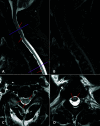Acute Transverse Myelitis (ATM):Clinical Review of 43 Patients With COVID-19-Associated ATM and 3 Post-Vaccination ATM Serious Adverse Events With the ChAdOx1 nCoV-19 Vaccine (AZD1222)
- PMID: 33981305
- PMCID: PMC8107358
- DOI: 10.3389/fimmu.2021.653786
Acute Transverse Myelitis (ATM):Clinical Review of 43 Patients With COVID-19-Associated ATM and 3 Post-Vaccination ATM Serious Adverse Events With the ChAdOx1 nCoV-19 Vaccine (AZD1222)
Abstract
Introduction: Although acute transverse myelitis (ATM) is a rare neurological condition (1.34-4.6 cases per million/year) COVID-19-associated ATM cases have occurred during the pandemic.
Case-finding methods: We report a patient from Panama with SARS-CoV-2 infection complicated by ATM and present a comprehensive clinical review of 43 patients with COVID-19-associated ATM from 21 countries published from March 2020 to January 2021. In addition, 3 cases of ATM were reported as serious adverse events during the clinical trials of the COVID-19 vaccine ChAdOx1 nCoV-19 (AZD1222).
Results: All patients had typical features of ATM with acute onset of paralysis, sensory level and sphincter deficits due to spinal cord lesions demonstrated by imaging. There were 23 males (53%) and 20 females (47%) ranging from ages 21- to 73- years-old (mean age, 49 years), with two peaks at 29 and 58 years, excluding 3 pediatric cases. The main clinical manifestations were quadriplegia (58%) and paraplegia (42%). MRI reports were available in 40 patients; localized ATM lesions affected ≤3 cord segments (12 cases, 30%) at cervical (5 cases) and thoracic cord levels (7 cases); 28 cases (70%) had longitudinally-extensive ATM (LEATM) involving ≥4 spinal cord segments (cervicothoracic in 18 cases and thoracolumbar-sacral in 10 patients). Acute disseminated encephalomyelitis (ADEM) occurred in 8 patients, mainly women (67%) ranging from 27- to 64-years-old. Three ATM patients also had blindness from myeloneuritis optica (MNO) and two more also had acute motor axonal neuropathy (AMAN).
Conclusions: We found ATM to be an unexpectedly frequent neurological complication of COVID-19. Most cases (68%) had a latency of 10 days to 6 weeks that may indicate post-infectious neurological complications mediated by the host's response to the virus. In 32% a brief latency (15 hours to 5 days) suggested a direct neurotropic effect of SARS-CoV-2. The occurrence of 3 reported ATM adverse effects among 11,636 participants in the AZD1222 vaccine trials is extremely high considering a worldwide incidence of 0.5/million COVID-19-associated ATM cases found in this report. The pathogenesis of ATM remains unknown, but it is conceivable that SARS-CoV-2 antigens -perhaps also present in the AZD1222 COVID-19 vaccine or its chimpanzee adenovirus adjuvant- may induce immune mechanisms leading to the myelitis.
Keywords: COVID-19; COVID-19 ChAdOx1 nCoV-19 vaccine; SARS-CoV-2 neurotropism; myelitis; neurological complications; transverse myelitis.
Copyright © 2021 Román, Gracia, Torres, Palacios, Gracia and Harris.
Conflict of interest statement
The authors declare that the research was conducted in the absence of any commercial or financial relationships that could be construed as a potential conflict of interest.
Figures

References
-
- Román GC, Spencer PS, Reis J, Bouguet A, El Alaoui Faris M, Katrak SM, et al. . on behalf of the WFN Environmental Neurology Specialty Group. The neurology of COVID-19 revisited: A proposal from the Environmental Neurology Specialty Group of the World Federation of Neurology to implement international neurological registries. J Neurol Sci (2020) 414:116884. 10.1016/j.jns.2020.116884 - DOI - PMC - PubMed
Publication types
MeSH terms
Substances
LinkOut - more resources
Full Text Sources
Medical
Research Materials
Miscellaneous

